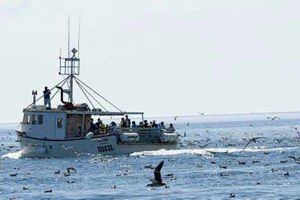Fun day in Fundy
It has the most dramatic tides in the world and more than its fair share of wildlife – particularly whales. Tim Earl explores the Bay of Fundy on the working boat, Day's Catch...

It has the most dramatic tides in the world and more than its fair share of wildlife – particularly whales. Tim Earl explores the Bay of Fundy on the working boat, Day's Catch...
*
HUGE tides which sweep up the Bay of Fundy, between New Brunswick and Nova Scotia produce a two-part living for local fishermen.
Their winters are spent catching lobsters, while in summer they take out tourists to see whales.
Lobsters and whales are attracted by the same thing – abundant food produced by the violent mixing of nutrient-rich waters with oxygen and sunlight on Canada's east coast.
There is no better example of this dual activity than MV Day's Catch, a tough working boat that operates out of Seal Cove Harbour on Grand Manan island.
She is about 20 tons with a generous cabin forward in which skipper/owner Peter Wilcox operates the navigation equipment required to find his lobster-pot bobbers or the tidal convergences in which whales congregate.
The rear deck is packed with pots and winches in winter, all stripped off to accommodate seats for 40 of the whale spotters and bird watchers who flock to the island in summer.
Peter's friend and colleague Durlan Ingersoll (technically, the boat's 'mate') shares the cabin in winter when the two men are pulling pots, but mingles with whale watchers in the summer.
His knowledge of the bay's birds, whales, dolphins, porpoises and fish is encyclopaedic and shared with the fervent followers.
Durlan's favourite spot is on the boat's cabin roof, from where he takes pictures and film of the whales and birds. Several of his film clips have been posted on YouTube (search for Durlan Ingersoll).
Exploitation of the marine resources started with Canada's First Nation people, a tribe locally known as the Mi'kmaq, who caught a variety of fish including cod, haddock and lobsters.
Indeed, they believed that the bay was home to a whale of such enormous proportions that it was the heaving of its mighty tail that caused the waters to slosh about.
Fishing has shaped the appearance of Grand Manan, an island a little larger than Jersey, which has pretty harbours along its east coast, one of which is Seal Cove.
(Seals are still found in the area and both harbour and grey can be seen from Day's Catch as she heads out to sea.)
But it is the tides that govern the way of life here.
Parts of the Bay of Fundy have a mean of 38.4ft and a regular spring tide of 52.5ft. Visiting Hopewell Rocks brings this home as a walk on the seabed at low tide gives views of the Flowerpot Rocks on which the high-tide mark is way overhead.
Some of the statistics are impossible to comprehend: at mid-tide, for example, the flow in Minas Channel equals the combined flow of all the rivers and streams on Earth. This is four cubic kilometers of water per hour, and it all comes pouring out again eight hours later.
The channel ends on the edge of the North American continental shelf, its mouth dropping into great depths.
It is a gathering place for great whales and flocks of seabirds drawn to the prolific feeding in the plankton-rich waters.
I have just returned from the island, where we went out on Day's Catch to experience the spectacle.
As with all such trips, the first hour or so is spent getting to the hot-spots, a sense of excitement and anticipation mingled with a little worry: will we see the whales and seabirds?
This is wildlife-watching and it can never be guaranteed. I well remember a 'whale expert,' who was booked to sail on a cruise ship on the first leg of a trip from Cape Town.
'We are certain to see whales as we sail,' she told the passengers I had been commissioned to look after for the whole cruise. I shuddered – it was a rash promise, even if the bay had been full the previous day.
Sure enough, none were seen.
I need not have worried in Canada. We were soon in waters over which huge flocks of tiny Wilson's storm-petrels were flitting, their long legs and webbed feet tiptoeing across the surface as they picked up tiny pieces of food, largely plankton, from the surface.
This species is reputed to be the most numerous on Earth. They nest along Brazil's Atlantic coast and the Pacific coasts of Chile and Peru.
While we were watching the flocks seeing out the austral winter in the Bay of Fundy (and also spread out across the north Atlantic), other vast congregations were feeding in the Pacific.
Few birdwatchers ever see them, however. They come ashore only to breed, and then at night, and the rest of their lives are spent wandering the oceans.
Whales started appearing in the same place. Humpbacks were loafing on the surface, clearly not feeding and just biding their time before the next meal of krill and small fish.
This is called logging and in calm conditions provides a brilliant opportunity to study the animals. We drifted up from behind them (the correct way to approach them) and had great views of their huge white flippers, 'splash-guards' around the blow-hole and strange 'hump' out of which the dorsal fin appears.
Better still, we could hear the great roar as the huge animals breathed out. As always, it was a thrilling encounter.
Fin whales provide a quite different experience. They are the locomotives of the ocean depths, built for speed and with peculiar asymmetric markings, which confuse shoals of fish and shrimps when the animals herd them into tight balls.
They congregate in fast tidal currents that are thick with fish and krill beneath the waves and shearwaters above.
These birds are just as extraordinary as the storm petrels. Great shearwaters are present in vast numbers of many thousands, and yet they breed in a small group of islands in the South Atlantic – Tristan da Cunha, 12,000 miles away.
There are a few sooty shearwaters in with them, also in the Bay of Fundy to escape the southern winter. They breed in the Falkland Islands and there is a good chance I have seen the very same birds while on my annual trip to this outpost of Great Britain.
Our trip on Day's Catch met its usual high standards in terms of both whales and birds. Durlan and I swapped rarities: I found him a black tern resting on a floating log while he pointed out Leach's storm petrel and Manx shearwater.
This latter may be a vagrant from the UK, where most of the world's population breed on Rum and other British islands.





